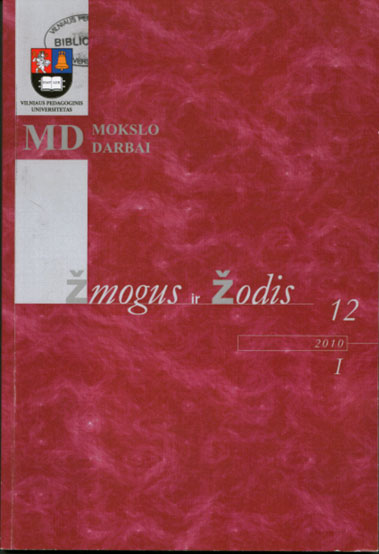Ašašninkų ir Kabelių šnektų fonetikos ypatumai: dabartinė padėtis
Phonetic Peculiarities of the Ašašninkai and Kabeliai Local Dialects (the Current Status)
Author(s): Žaneta Markevičiene Subject(s): Language and Literature Studies
Published by: Vytauto Didžiojo Universitetas
Keywords: dialect; local dialect; substratum, hypercorrection.
Summary/Abstract: The local dialects of Ašašninkai and Kabeliai belong to the Southern Aukštaitian dialect of Lithuanian. Their location is the southern part of the Varėna region. The said local dialects are well known to linguists due to the so-called mixing up of the consonants s and z with š and ž. It was found out during the 1965 expedition that both the aforementioned phenomena were still widely spread at that period. Numerous people would still then pronounce s, z instead of š, ž: zmɔ•gùs (cf. žmɔ•gùs ‘a man, a person’ in neighbouring local dialects), asarùkαs (cf. ašarùkαs ‘a little perch’), zõ•dis (cf. žõ•dis ‘a word’), zuví•tẹ․ (cf. žuví•tẹ․ ‘a small fish’), sìtαs (cf. šìtαs ‘this’), etc. This feature is interpreted as a relic of the Jatvingian tongue, as the Jatvingian tribe used to live at the said territory. Although pronunciation of the consonants s, z was also spotted in dialects where no linguistic substratum existed (e.g. in the Vilniškiai subdialect), no arguments exist allowing denial of heritage from the Jatvingian tongue in the Ašašninkai and Kabeliai local dialects. Presently, this feature has been non-systematically retained among several elderly people only, almost all of them male. In 1965, a contrary phenomenon was alive, too, i.e. substitution of s, z with š, ž. E.g. pí•rmini․kaš an‿žɔɔtèknikẹ․š akiẽš netùri║ (cf. pí•rmini․kas an‿zɔɔtèknikẹ․s akiẽs netùri è ‘the chairman has it in for the zootechnician’). It is a phenomenon of hypercorrection, i.e. exaggerated efforts to avoid speaking dialectal language. Presently, this feature is almost extinct. The consonants s, z are substituted with š, ž in some proper names, e.g. krìštus (cf. krìstus ‘Christ’), mušteikὰ (cf. musteikὰ ‘Musteika, a village name’), šìmɔ․nαs (cf. sìmɔ․nαs ‘Simon’). Another almost extinct phenomenon is mixing up consonant pair soft t, d and k, g, e.g. kí•ltαs (cf. tí•ltαs ‘a bridge’), delažìs (cf. gelažìs ‘iron’). The so-called primary dzūkian feature (tj, dj > c, dz) has been retained with great consistency: ʒåũksmαs ‘joy’, cà ‘here’, stà․cαs upright. The secondary dzūkian feature (tì > c, tie > cie, d > dz, die > dzie) has not been retained so systematically. Although they say ʒiẽvαs ‘God’, cìk ‘only’, forms like tíe ‘those’ mαitìnɔ․ ‘fed’, dektìnẹ․ ‘brandy’, tìkrαs ‘real / sure’, dí•gɔ․ ‘germinated’ etc. also exist in the dialect. Speakers of the Southern Aukštaitian dialect of Lithuanian have most probably retained the old forms of the pronouns jis, jį: ìs, ĩ ‘he, him’. Initial dropping of the consonant j is hardly believable in this case, as the consonant j is usually added rather than dropped at the initial position in this dialect.
Journal: Žmogus ir žodis
- Issue Year: 12/2010
- Issue No: 1
- Page Range: 48-51
- Page Count: 4
- Language: Lithuanian

